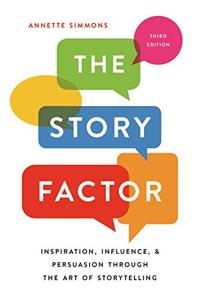
Want to learn the ideas in The Story Factor better than ever? Read the world’s #1 book summary of The Story Factor by Annette Simmons here.
Read a brief 1-Page Summary or watch video summaries curated by our expert team. Note: this book guide is not affiliated with or endorsed by the publisher or author, and we always encourage you to purchase and read the full book.
Video Summaries of The Story Factor
We’ve scoured the Internet for the very best videos on The Story Factor, from high-quality videos summaries to interviews or commentary by Annette Simmons.
1-Page Summary of The Story Factor
Overview
The next time you have a presentation coming up, think about using stories. Determine the key points you want to make and then look for anecdotes that will highlight those points in a clear way. For example, if you’re promoting organic food over non-organic food, don’t quote statistics on phosphates and vitamins. Tell a story of how farmers can hug their children because they’re not covered in pesticides from working with non-organic crops. Use these kinds of stories instead to pack more punch into your presentations.
For thousands of years, people have wanted to hear stories. People enjoy watching and listening to movies or reading books that are full of interesting stories. Why do we like hearing these kinds of stories? You might think it’s because we need facts in order to make decisions, but the real reason is that a good story helps us understand the facts better by providing context for them. And if you’re telling the story, you can influence how your audience interprets those facts. This makes storytelling an incredibly powerful tool when used properly.
How to Tell Good Stories
Big Idea #1: Stories help us understand the world. They are also effective tools for persuading others to see things our way.
In order to tell a good story, we need to know what makes a good one. A good story is an argument that simplifies the world and helps us understand it better. The world today can be chaotic and complicated, but stories help listeners organize their thoughts about the subject matter at hand. For example, if someone has lost their job or gone through a tough break up, they may find comfort in hearing about someone who’s been there before them.
Stories can be more effective than direct guidance. That’s because stories’ lessons are adaptable to other situations, whereas the effects of direct guidance only apply in one situation and then become irrelevant.
If you have a colleague who sends obnoxious-sounding emails around the office, you could tell him to stop. However, it would be more effective if he heard about someone who lost their job due to a misunderstanding in an email and then changed his behavior accordingly.
Stories are a great way to teach lessons indirectly. For example, if you tell your colleague about an email that was rude and unprofessional, he’ll remember the lesson better than if you just told him directly not to be rude or unprofessional in his emails.
Big Idea #2: When telling a story, don’t just rely on words; use your whole body.
Let’s say you have a story to tell. You know what the story is, but how do you communicate it properly? It all depends on your audience and what kind of medium you’re using for storytelling—voice, face, hands and body are all important when telling a good story.
You can use hand gestures to add meaning to your words and paint a picture for the audience. You should also use facial expressions to help people relate to your story. If you are angry about something, show that on your face or smile if you’re happy about another point in the plot. When speaking, prioritize things that listeners can imagine vividly because this helps them believe what you say more easily.
For example, if you want your audience to feel like they’re in the story with you, try making sounds that make them feel as though they are experiencing what is being described. For instance, let’s say there’s a scene where it’s windy and cold outside. You can blow on the microphone to simulate howling winds. This will make your listeners more emotionally invested in the story because of their senses having been engaged through hearing or feeling something similar to what you’re describing.





